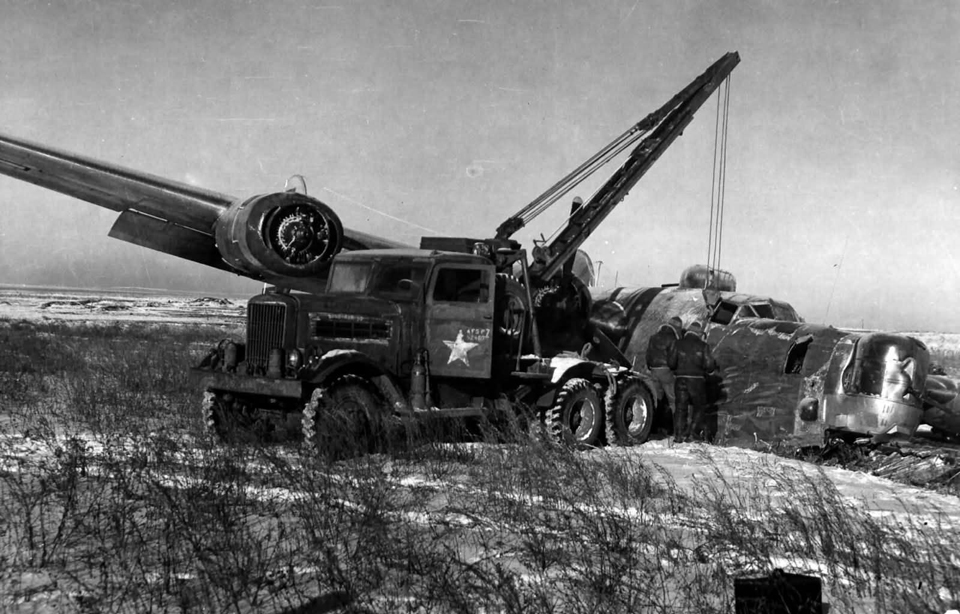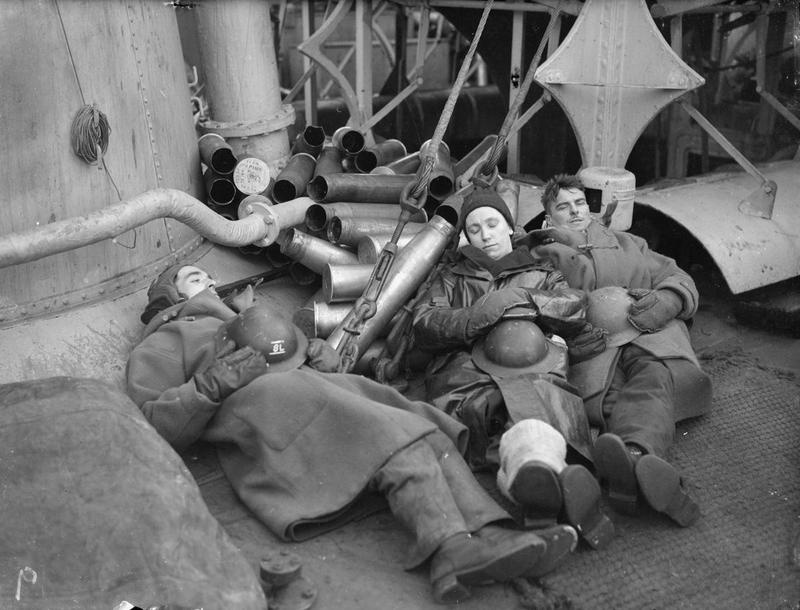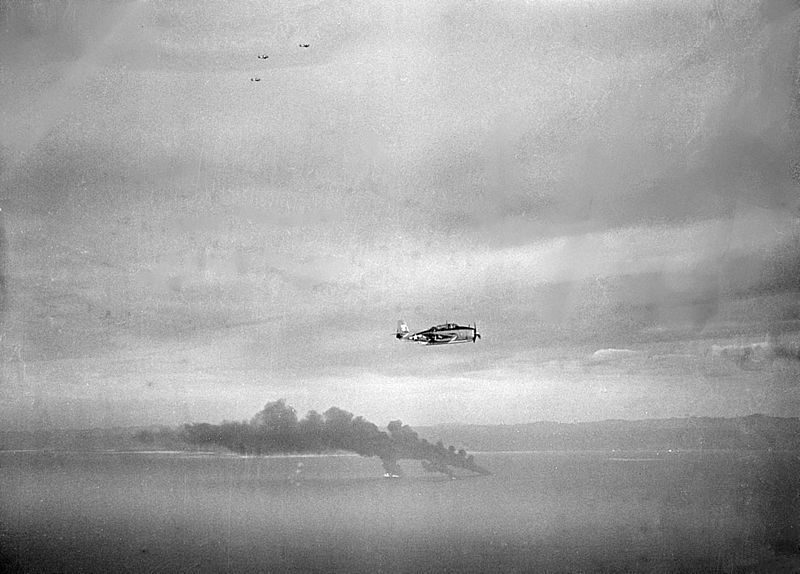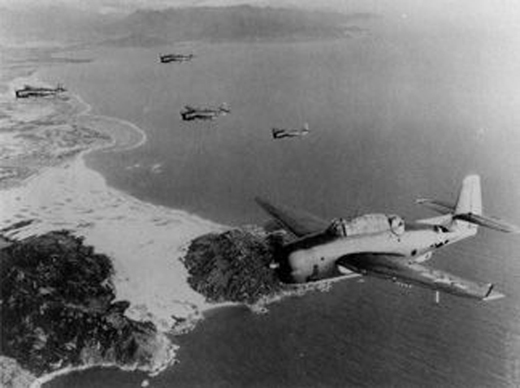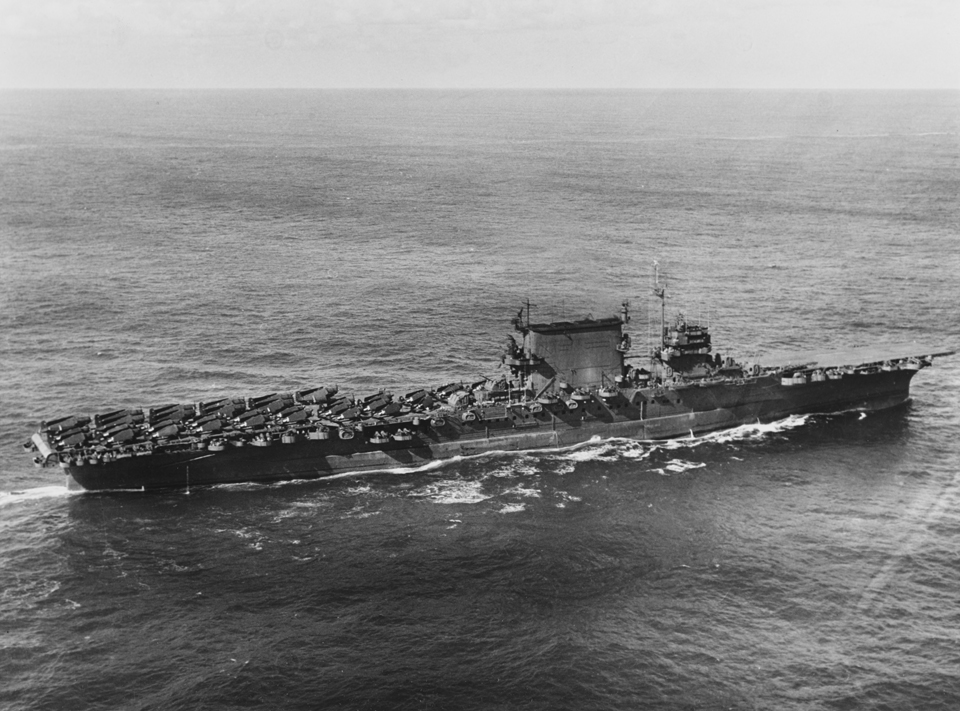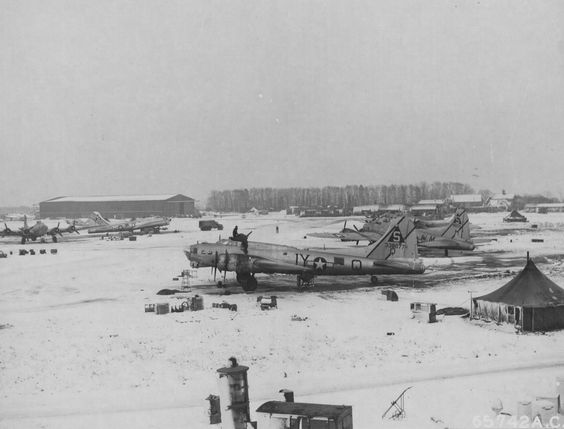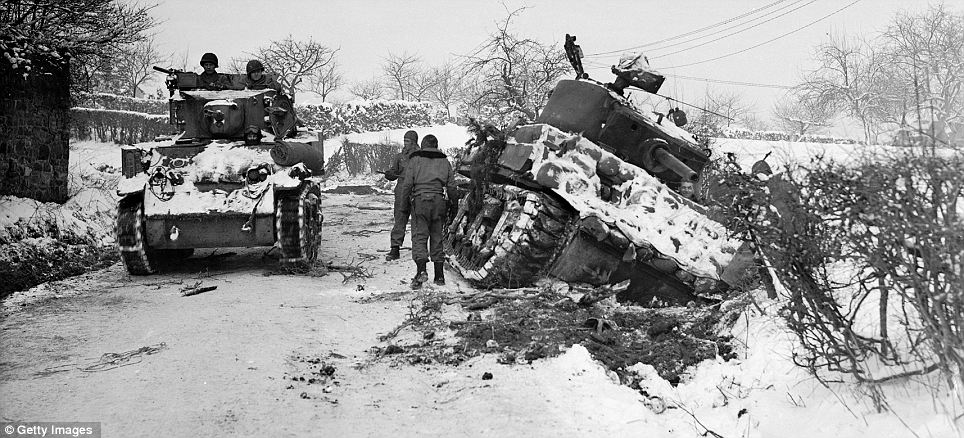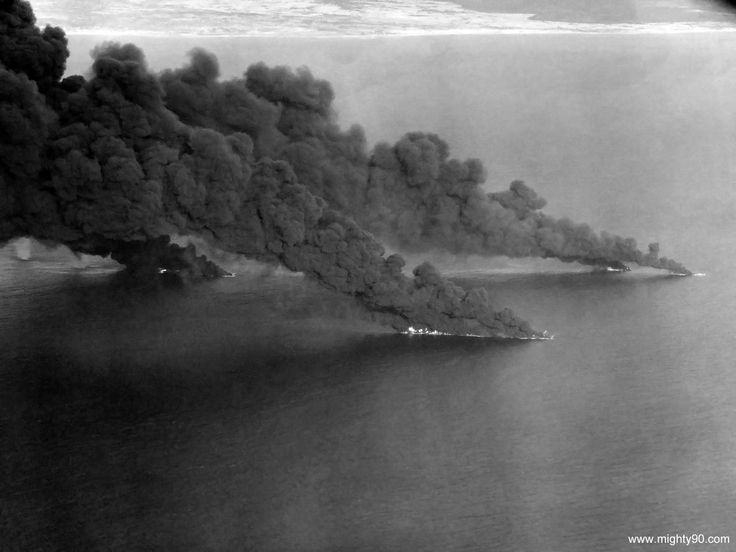Air Operations, CBI
BURMA- More than 70 10th Air Force fighter-bombers attack troops, troop movements, motor vehicles, and supplies at 8 locations.
- 16 fighter-bombers support Allied ground forces around Si-U and Lawa.
- 6 14th Air Force B-25s attack a bridge at Wan Mai-Lo.
- 14th Air Force fighter-bombers attack targets of opportunity in the Muse area.
- Night-flying scout bombers and fighters launched at 0330 hours from Task Group 38.5, fail to locate the Japanese battleship-carriers thought to be in Camranh Bay. 850 Task Force 38 aircraft mount a one-day total of 984 attack sorties against Japanese airfields and shipping along the west coast of French Indochina from Tourane to Saigon.
- ;An afternoon strike against shipping around Saigon by more than 500 carrier bombers and fighters is instigated by a report in the morning from French Underground operatives in the city itself. In all during the day, claims are made for the destruction of 44 enemy vessels (including a French Navy cruiser) aggregating nearly 133,000 tons. It is also estimated that 20 Japanese seaplanes are destroyed on the water at Camranh Bay and 77 land-based aircraft are destroyed on the ground, including 50 that arrive from Singapore after dark.
- 23 US Navy and Marine Corps carrier aircraft are lost, 16 to anti-aircraft fire and 7 in operational accidents. Also, a 14th Air Force B-24 is shot down by Marine F4Us after its crew fails to respond to recognition calls and procedures and first opens fire on the unfamiliar F4Us. Most of the downed airmen are rescued.
- VF-3 F6Fs down 1 Ki-49 'Helen' bomber, 2 D3A 'Val' dive bombers, 1 A6M Zero, and 3 Ki-61 'Tony' fighters over Saigon between 0810 and 0840 hours.
- a VF-4 F6F down 1 E13A 'Jake' reconnaissance plane over Quinon at 0855 hours.
- A VF-3 F6F downs a G3M 'Nell' bomber near Padaran Bay at 1020 hours.
Air Operations, Formosa
During the night, 2 63rd Heavy Bomb Squadron SB-24s attack Heito.
[Air Operations, Europe
RAF BOMBER COMMANDDaylight Ops:
- 32 Lancasters and 1 Mosquito of Nos. 9 and 617 Squadrons attack U-boat pens and shipping in Bergen harbour. A local report says that 3 Tallboys penetrate the 3½-metre-thick roof of the pens and cause severe damage to workshops, offices and stores inside.
- 3 Lancasters of No. 617 Squadron and 1 from No. 9 Squadron are lost. The Germans tell the local people that 11 bombers have been shot down.
- 2 Mosquito fighters of No. 100 Group fly long-range escort for an air-sea rescue operation and 2 Stirlings fly RCM sorties.
- There are no losses.
Minor Ops
- 11 Mosquitos are sent to Bochum and 9 to Recklinghausen, both to bomb synthetic benzol plants, and 32 Halifaxes lay mines off Flensburg and Kiel.
- 4 Halifaxes are lost.
ITALY:
- Bad weather grounds most of the US Air Forces, but XXII TAC P-47s attack road and rail targets in the Po River valley.
- Despite rough seas, Task Group 77.4 TBMs and FMs are able to provide adequate support for US 6th Army ground forces in the Lingayen Gulf area.
- FEAF B-24s attack the San Jose del Monte, Luzon area and the Batangas and Legaspi airfields on Luzon, and the Matina airfield on Mindanao.
- V Bomber Command B-25s attack warehouses at Fabrica, Negros.
- 2 VC-11 FMs down an E13A 'Jake' reconnaissance plane off western Luzon at 0830 hours.
- FMs down 3 fighters over Luzon between 0845 and 1030 hours.
- VC-76 and VC-78 FMs down 1 Ki-44 'Tojo' fighter and 2 Ki-43 'Oscar' fighters between 10 and 20 miles from Task Unit 77.4.5 between 1830 and 1834 hours.
- Beginning their attacks at sunrise, kamikazes severely damage a US destroyer escort and a destroyer-transport.
- During the late afternoon, a kamikaze superficially damages a freighter, and in a larger raid at 1830 hours, another kamikaze crashes into a transport and kills 129 aboard her.
- Between January 8 and 12, all but 10 of the surviving Japanese aircraft on Luzon are evacuated to Formosa. Only 47 aircraft and fewer than a hundred pilots are thus saved.
-
[
Air Operations, Philippines
Air Operations, Volcano Islands
28 VII Bomber Command B-24s attack Iwo Jima.
[Battle of the Atlantic
U-382 is sunk at Wilhelmshaven during an RAF raid on that port.
| Class | Type VIIC/41 |
| CO | Oberleutnant zur See Günther Schimmel |
| Location | North Sea, Wilhelmshaven |
| Cause | Air attack |
| Casualties | Unknown |
| Survivors | Unknown |
Burma
In the British XV Corps sector the 3rd Commando Bde lands after an air and naval bombardment at Myebon on the Arakan coast, establishing a firm bridgehead which the Japanese try unsuccessfully to destroy with vigorous counterattacks.
The 19th Indian Div takes bridgeheads over the Irrawaddy north of Mandalay at Kyaukmyaung and Thabeikkyin. Fierce Japanese attacks in these areas immediately begin.
[CBI
Col Lewis A. Pick leads the first convoy of 113 vehicles, mostly cargo trucks, jeeps, and amublances out of Ledo and bound for Kunming, China. The convoy has representation from every engineer unit that has worked on the road, as well as 65 members of the press.
[Eastern Front
A major Soviet offensive begins all along the front from the Baltic to the Carpathians. The principal attacks are by Konstantin Rokossovsky's 2nd Belorussian Front with 9 armies immediately north of Warsaw; by Georgi Zhukov's 1st Belorussian Front opposite Warsaw and to the south with 7 armies initially; and by Ivan S. Konev's 1st Ukraine Front from the salient west of Sandomierz also with 7 armies in the front line. There are additional efforts by 3rd Belorussian and both Baltic Fronts against the German forces in East Prussia and those cut off in Latvia. The defending German forces are mostly from Army Group Center under Gen Ferdinand Schörner comprising the 2nd Army under Walter Weiss, the 4th under Friedrich Hossbach and the 3rd Panzer Army under Erich Rauss and Army Group A under Gen Josef Harpe comprising 1st Panzer Army under Gotthard Heinrici, the 17th Army under Friedrich Schulz, the 4th Panzer Army under Fritz Graser, the 9th Army under Heinrich Freiherr von Luttwitz, 30 infantry divisions, 5 tank divisions and 50 autonomous battalions. 7 fortified lines have been prepared between the Vistula and the Oder, that on the Vistula being the most strongly manned. 2nd Army will bear the brunt of Rokossovsky's attack; 9th Army faces Zhukov; and 4th Pzr Army faces Konev.
In total 5.3 million Russians are engaged on the Eastern Front, in 527 infantry divisions, 43 artillery divisions, 302 tank brigades, with 13,500 armored vehicles and self-propelled guns. 1.8 million German troops are engaged in 164 divisions of which 38 are in the Army Group South, 99 in Army Groups A and Center, and 27 in northern Latvia. These German troops are outnumbered by at least 4 or 5 to 1 in all classes of equipment, and despite brave resistance they will have no answer to the Red Army's power.
Operation VISTULA-ODER is started by the 1st Ukraine Front, which advances from the Sondomierz bridgehead toward Breslavia, and the 2nd Belorussian Front, which throws in 9 armies in a surprise attack against the German 2nd Army on the Narew River north of Warsaw.
The first German defensive line on the Vistula is breached by the 1st Ukraine Front within 24 hours.
POLANDIn response to Churchill's request to relieve pressure on the Western Allies being attacked in the Ardennes, Stalin opens the Soviet Vistula-Oder Offensive today. The 1st Ukrainian Front (3rd Guards, 4th Guards Tank, 5th Guards, 6th, 13th, 21st, 52nd, 59th and 60th Armies) launches a devastating attack against the German 4th Panzer and 17th Armies, which are soon reeling. The Soviet 4th Tank Army is then fed into the attack, its tanks nearing Kielce.
HUNGARYThe IV SS Panzer Corps is within 12 miles of Budapest, but is then ordered to pull back.[MORE]
[Germany, Armed Forces
Fuel shortages are crippling the army's mobility. Units are increasingly using horses to move supplies and tow artillery pieces. There are currently 1,136,318 horses on the books of the Wehrmacht, of which 923,679 are on active service.
[Indochina
There are air attacks from the planes of the carriers of TF 38 against Japanese installations at the naval base at Camranh Bay and other area in Indochina. TG 38.5 continues the attacks from its specially trained carriers. Japanese shipping losses to the attacks amount to 29 ships of 116,000 tons. 11 small warships are also sunk including the training cruiser Kashii, the frigate Chiburi, the submarine chasers Nos. 31 and 43, the minesweeper No. 101, transport No. 140, patrol boat No. 103 and coast defense vessels Nos. 17, 19, 23, 35, 43 and 51.
[Italy
The Cremona combat group under Gen Clemente Primieri, incorporated in the Canadian I Corps, British 8th Army, goes into line to replace the Canadian 1st Div in the sector between Alfonsine (Ravenna) and the Adriatic coast. This is the first of 6 big formations formed by the Italian army in the second half of 1944 in close collaboration with the Allied military mission in Italy. The others ar Friuli, Legnano, Folgore, Mantova and Piceno.
[Philippines
On Luzon in the XIV Corps sector the US 40th Div occupies Port Sual and pushes on westward toward Alaminos without opposition. In the I Corps sector, the task given to the units is to ensure control of the road from Damortis inland to Rosario.
On Mindoro Americans and Filipino guerillas go ahead with the slow occupation of the island. The American concentrate at Pinamalayan to launch an attack in force on Calapan, where the main body of the Japanese garrison is concentrated.
US ships damaged by suicide planes in the area include the destroyer escorts Richard W. Suesens (DE-342) and Gilligan (DE-508), the attack transport Zeilin (APA-3) and landing craft LST-700. Damaged by accidental US naval gunfire are the landing craft LST-710 and LST-778.
[Western Front
In the US 1st Army sector, the 2nd Arm Div, VII Corps, opens an offensive in the Houffalize-Laroche sector, Further north, the 106th Div, US XVIII Airborne Corps, establishes a bridgehead over the Amblève River south of Stavelot.
The German divisions of the 5th Panzer Army and the 7th Army continue to retire under pressure from units of the US 3rd Army; the 87th Div, VIII Corps, takes Amberloup, Lavacherie, Fosset and Sprimont, while further south the 6th Arm Div, III Corps, enters Wardin.
[Images from January 12, 1945
|
|
|
|
|
|
|
|
